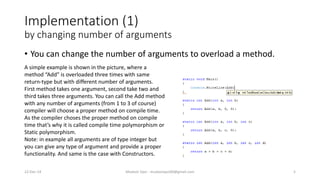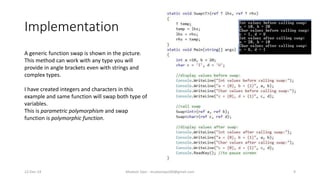OOP - Polymorphism
- 1. Polymorphism Definition, types and implementation 22-Dec-14 Mudasir Qazi - [email protected] 1
- 2. Contents / Agenda • Definition and Types • Ad-hoc polymorphism • Implementation of all types of ad-hoc polymorphism • Parametric Polymorphism • Implementation of parametric polymorphism • Subtyping polymorphism • Implementation of Subtyping polymorphism 22-Dec-14 Mudasir Qazi - [email protected] 2
- 3. Definition • Polymorphism is an object-oriented programming concept that refers to the ability of a variable, function or object to take on multiple forms. A language that features polymorphism allows developers to program in the general rather than program in the specific. • Following are the main types of polymorphism 1. Ad-hoc Polymorphism 2. Parametric Polymorphism 3. Subtyping Polymorphism 22-Dec-14 Mudasir Qazi - [email protected] 3
- 4. Ad-hoc Polymorphism • It is also known as Function Overloading or Static Binding and also Operator Overloading. • Ad-hoc Polymorphism is a phenomenon in which you can create multiple functions with the same name but that have different headers or signature. • It can be achieved using following ways 1. By changing the type of arguments 2. By changing the order of arguments 3. By changing number of arguments • You can not change the return-type of a function in overloading. 22-Dec-14 Mudasir Qazi - [email protected] 4
- 5. Implementation (1) by changing number of arguments • You can change the number of arguments to overload a method. A simple example is shown in the picture, where a method “Add” is overloaded three times with same return-type but with different number of arguments. First method takes one argument, second take two and third takes three arguments. You can call the Add method with any number of arguments (from 1 to 3 of course) compiler will choose a proper method on compile time. As the compiler choses the proper method on compile time that’s why it is called compile time polymorphism or Static polymorphism. Note: in example all arguments are of type integer but you can give any type of argument and provide a proper functionality. And same is the case with Constructors. 22-Dec-14 Mudasir Qazi - [email protected] 5
- 6. Implementation (2) by changing type of arguments • You can achieve this by just changing the type of arguments. 22-Dec-14 Mudasir Qazi - [email protected] 6 You see that, we don’t change the number of arguments here in this example, but we change the type from integer to double. And by doing this we have achieved the polymorphism.
- 7. Implementation (3) by changing order of arguments • You can also just change the order of arguments to overload a method 22-Dec-14 Mudasir Qazi - [email protected] 7 Here in this example, there are two overloaded method in the class. We overload them by just changing the order of arguments. In first method, integer is 1st argument and string is 2nd argument but in the second method string is 1st argument and integer is the 1st argument.
- 8. Parametric Polymorphism • It is also known as Template Polymorphism or Late/dynamic Binding. • Parametric polymorphism allows a function or a data type to be written generically, so that it can handle values identically without depending on their type. Parametric polymorphism is a way to make a language more expressive, while still maintaining full static type-safety. • The concept of parametric polymorphism applies to both data types and functions. A function that can evaluate to or be applied to values of different types is known as a polymorphic function. A data type that can appear to be of a generalized type (e.g., a list with elements of arbitrary type) is designated polymorphic data type like the generalized type from which such specializations are made. 22-Dec-14 Mudasir Qazi - [email protected] 8
- 9. Implementation 22-Dec-14 Mudasir Qazi - [email protected] 9 A generic function swap is shown in the picture. This method can work with any type you will provide in angle brackets even with strings and complex types. I have created integers and characters in this example and same function will swap both type of variables. This is parametric polymorphism and swap function is polymorphic function.
- 10. Subtyping Polymorphism • It is also known as Method Overriding or Late Binding or Dynamic Binding or Inclusion Polymorphism. • Method Overriding is when a method defined in a superclass or interface is re-defined by one of its subclasses, thus modifying/replacing the behavior the superclass provides. The decision to call an implementation or another is dynamically taken at runtime, depending on the object the operation is called from. Notice the signature of the method remains the same when overriding. 22-Dec-14 Mudasir Qazi - [email protected] 10
- 11. Implementation 22-Dec-14 Mudasir Qazi - [email protected] 11 The picture shows the implementation of method overriding or subtyping polymorphism. Abstract class has a method that is re-defined in each concrete class with respect to their requirements with same signature. In the main method, when we create objects of concrete classes and call there talk method we get different output as implemented. letsHear(new Cat()) => Meow! letsHear(new Dog()) => Woof! The abstract class’s method is overridden on runtime, the compiler sees which object is calling the method, if that method is available in same class then it would be called, if not, then super class’s method would be called.
- 12. Casting in Polymorphism (1) • Two types of castings are done in polymorphism 1. Up Casting 2. Down Casting • Up-casting is casting to a supertype, while Down-casting is casting to a subtype. Supercasting is always allowed, but subcasting involves a type check and can throw a ClassCastException. A cast from from Dog to an Animal is a upcast, because a Dog is-a Animal. In general, you can upcast whenever there is an is-a relationship between two classes. Downcasting would be something like this: • Animal animal = new Dog(); • Dog castedDog = (Dog) animal; • Basically what you're doing is telling the program that you know what the runtime type of the object really is. The program will do the conversion, but will still do a sanity check to make sure that it's possible. In this case, the cast is possible because at runtime animal is actually a Dog even though the static type of animal is Animal. However, if you were to do this: • Animal animal = new Animal(); • Dog dog = (Dog) animal; • You'd get a ClassCastException. The reason why is because animal's runtime type is Animal, and so when you tell the runtime to perform the cast it sees that animal isn't really a Dog and so throws a ClassCastException. To call a superclass's method you can do super.method() or be performing the upcast. To call a subclass's method you have to do a downcast and risk the ClassCastException. 22-Dec-14 Mudasir Qazi - [email protected] 12
- 13. Casting in Polymorphism (2) 22-Dec-14 Mudasir Qazi - [email protected] 13













